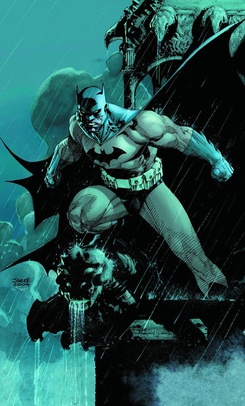
Batman is a superhero who appears in American comic books published by DC Comics. Batman was created by the artist Bob Kane and writer Bill Finger, and debuted in the 27th issue of the comic book Detective Comics on March 30, 1939. In the DC Universe, Batman is the alias of Bruce Wayne, a wealthy American playboy, philanthropist, and industrialist who resides in Gotham City. His origin story features him swearing vengeance against criminals after witnessing the murder of his parents, Thomas and Martha, as a child, a vendetta tempered by the ideal of justice. He trains himself physically and intellectually, crafts a bat-inspired persona, and monitors the Gotham streets at night. Kane, Finger, and other creators accompanied Batman with supporting characters, including his sidekicks Robin and Batgirl; allies Alfred Pennyworth and James Gordon; love interest Catwoman; and foes such as the Penguin, the Riddler, Two-Face, and his archenemy, the Joker.

Batman: Year One is an American comic book story arc written by Frank Miller and illustrated by David Mazzucchelli. Year One was originally published by DC Comics in Batman #404–407 monthly issues format in 1987. The story recounts Batman's first year as a crime-fighter as well as exploring the life of recently transferred Gotham police detective Jim Gordon, building towards their first encounter and their eventual alliance against Gotham's criminal underworld.

Gotham City, or simply Gotham, is a fictional city in the Eastern United States that serves as the primary city appearing in American comic books published by DC Comics. It is best known as the home of the superhero Batman and his allies and foes. Created by writer Bill Finger and artist Bob Kane, the city was first identified as Batman's place of residence in Batman #4 and has since been the primary setting for stories featuring the character. In most of its incarnations, Gotham is depicted as one of the most crime-ridden cities in the world.
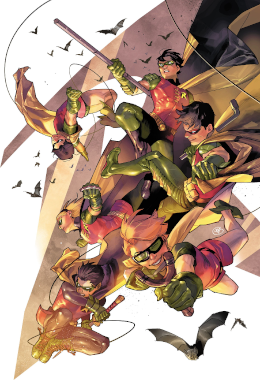
Robin is the alias of several superheroes appearing in American comic books published by DC Comics. The character was created by Bob Kane, Bill Finger, and Jerry Robinson to serve as a junior counterpart and the sidekick to the superhero Batman. As a team, Batman and Robin have commonly been referred to as the Caped Crusaders and the Dynamic Duo. The character's first incarnation, Dick Grayson, debuted in Detective Comics #38. Conceived as a way to attract young readership, Robin garnered overwhelmingly positive critical reception, doubling the sales of the Batman titles. Robin's early adventures included Star Spangled Comics #65–130 (1947–1952), the character's first solo feature. He made regular appearances in Batman-related comic books and other DC Comics publications from 1940 through the early 1980s, until the character set aside the Robin identity and became the independent superhero Nightwing.
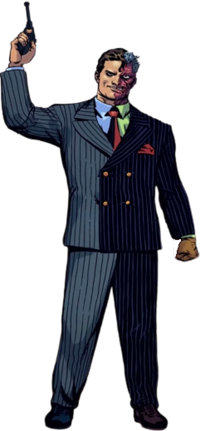
Two-Face is a supervillain appearing in American comic books published by DC Comics. The character was created by Bob Kane, and first appeared in Detective Comics #66. He has become one of the superhero Batman's most enduring enemies belonging to the collective of adversaries that make up his rogues gallery.

Alfred Thaddeus Crane Pennyworth, originally Alfred Beagle and commonly known simply as Alfred, is a fictional character appearing in American comic books published by DC Comics, most commonly in association with the superhero Batman.

James W. "Jim" Gordon Sr. is a character appearing in American comic books published by DC Comics, most commonly in association with the superhero Batman. Created by Bill Finger and Bob Kane as an ally of Batman, the character debuted in the first panel of Detective Comics #27, Batman's first appearance, making him the first Batman supporting character ever to be introduced.
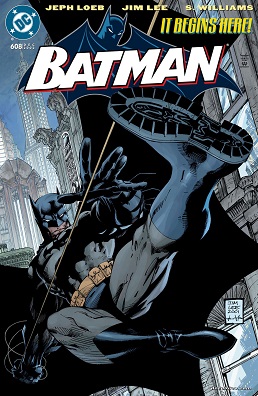
"Batman: Hush" is an American comic book story arc published by DC Comics featuring the superhero Batman. It was published in monthly installments within the comic book series Batman, running from issue #608–619 in October 2002 until September 2003. The story arc was written by Jeph Loeb, penciled by Jim Lee, inked by Scott Williams, and colored by Alex Sinclair, under the editorship of Bob Schreck.

Batman: The Dark Knight Strikes Again, also known as DK2, is a 2001–2002 DC Comics three-issue limited series comic book written and illustrated by Frank Miller and colored by Lynn Varley, featuring the fictional superhero Batman. The series is a sequel to Miller's 1986 miniseries The Dark Knight Returns. It tells the story of an aged Bruce Wayne who returns from three years in hiding, training his followers and instigating a rebellion against Lex Luthor's dictatorial rule over the United States. The series features an ensemble cast of superheroes including Catgirl, Superman, Wonder Woman, Plastic Man, Green Arrow, The Flash, and the Atom.

The Bat-Signal is a distress signal device appearing in American comic books published by DC Comics, as a means to summon the superhero, Batman. It is a specially modified searchlight with a stylized emblem of a bat affixed to the light, allowing it to project a large bat symbol onto cloudy night skies over Gotham City.

Caroline Keene "Carrie" Kelley is a superheroine from Frank Miller's graphic novels The Dark Knight Returns (1986) and its sequels The Dark Knight Strikes Again (2001–2002) and The Dark Knight III: The Master Race (2015–2017). She becomes the new Robin in The Dark Knight Returns when she saves Batman's life. Later in The Dark Knight Strikes Again, she adopts the identity Catgirl, and in The Dark Knight III: The Master Race, she adopts the identity Batwoman. She was the first full-time female Robin in the history of the Batman franchise, though Julie Madison had passed off as Robin for a brief time in a Bob Kane story published in Detective Comics #49 in March 1941.

Thomas Alan Wayne, M.D. is a fictional character appearing in American comic books published by DC Comics. He is the father of Bruce Wayne (Batman), and husband of Martha Wayne as well as the paternal grandfather of Damian Wayne. Wayne was introduced in Detective Comics #33, the first exposition of Batman's origin story. A gifted surgeon and philanthropist to Gotham City, Wayne inherited the Wayne family fortune after Patrick Wayne. When Wayne and his wife are murdered in a street mugging, Bruce is inspired to fight crime in Gotham as the vigilante Batman.

In addition to DC Comics books, the superhero Robin also appears in other media, such as films, television and radio. Dick Grayson, Jason Todd, Tim Drake, Stephanie Brown, and Damian Wayne are examples of the characters who use the name Robin.

The Batman franchise, based on the fictional superhero Batman who appears in American comic books published by DC Comics, has seen the release of various films. Created by Bob Kane and Bill Finger, the character first starred in two serial films in the 1940s, Batman and Batman and Robin. The character also appeared in the 1966 film Batman, which was a feature film adaptation of the 1960s television series starring Adam West and Burt Ward, who also starred in the film. Toward the end of the 1980s, the Warner Bros. studio began producing a series of feature films starring Batman, beginning with 1989's Batman, directed by Tim Burton and starring Michael Keaton. Burton and Keaton returned for the 1992 sequel Batman Returns, and in 1995, Joel Schumacher directed Batman Forever, with Val Kilmer as Batman. Schumacher also directed the 1997 sequel Batman & Robin, which starred George Clooney. Batman & Robin was poorly received by both critics and fans, leading to the cancellation of a sequel titled Batman Unchained.

Batman: The Dark Knight Returns is a two-part direct-to-video adult animated superhero film, an adaptation of the 1986 comic book The Dark Knight Returns by Frank Miller and is set in the same continuity as Batman: Year One. It was directed by Jay Oliva, who worked as a storyboard artist on Man of Steel, Under the Red Hood, Year One and Batman v Superman: Dawn of Justice. Several other Batman veterans were also involved in the film. Part 1 was released on September 25, 2012, and Part 2 was released on January 29, 2013. A deluxe edition combining both films was released on October 8, 2013. Part 1 is the 15th film, and Part 2 is the 16th film, of the DC Universe Animated Original Movies.

The Dark Knight III: The Master Race, also stylized as DK III: The Master Race and later collected as Batman: The Dark Knight – Master Race, is a 2015–2017 nine-issue DC Comics limited series co-written by Frank Miller and Brian Azzarello and illustrated by Miller, Andy Kubert, and Klaus Janson.
The Mutants is the name of a fictional street gang appearing in American comic books published by DC Comics. While the Mutants were first seen in The Dark Knight Returns, there were other incarnations of the Mutants that appeared in later Batman comics.

The character Two-Face was created by Bob Kane and first appeared in Detective Comics #66. However, he did not appear outside comics until half a century later in Batman: The Animated Series. Two-Face has since been substantially adapted from the comics into various forms of media, such as feature films, television series and video games. Two-Face has been voiced by Richard Moll in the DC Animated Universe, Troy Baker in the Batman: Arkham series, Billy Dee Williams in The Lego Batman Movie, and William Shatner in Batman vs. Two-Face. His live-action portrayals include Billy Dee Williams in Batman (1989), Tommy Lee Jones in Batman Forever, Aaron Eckhart in The Dark Knight, Harry Lawtey in Joker: Folie à Deux, and Nicholas D'Agosto in the television series Gotham. In 2009, Two-Face was ranked #12 on IGN's list of the Top 100 Comic Book Villains of All Time.
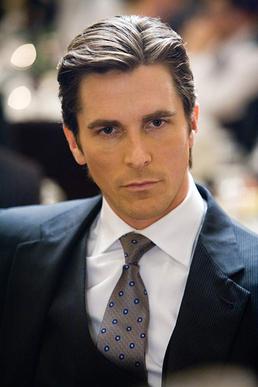
Bruce Wayne, also known by his superhero vigilante persona Batman, is a fictional character who is the main protagonist in Christopher Nolan's trilogy of superhero films, based on the DC Comics character of the same name, created by Bill Finger and Bob Kane. Portrayed by Christian Bale, this version of Batman is arguably explored more in-depth compared to that of the previous film series by Tim Burton and Joel Schumacher, as the Dark Knight film series provides a full arc for the character and was intended by Nolan to be more realistic than previous portrayals.




















